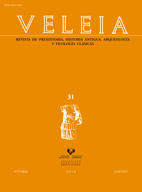Iberian "kutu" and the iberian abecedaries
##plugins.themes.bootstrap3.article.main##
##plugins.themes.bootstrap3.article.sidebar##
Abstract
This paper presents the hypothesis that identifies three texts as Iberian non-dual abecedaries on the basis of a statistical irregularity. They consist of one considerable long segment, but almost all of the signs are different. The texts identified as abecedaries are a rock inscription from L'Esquirol and the two texts from the spindle whorl from Can Rodon. Two of the texts begin with the same sequence, kutukiŕbitatiko, a fact that also identifies other texts that begin with the same sequence as non-dual abecedaries: these are an unpublished text on rock in Latour de Carol and probably a short text on a dolium from Val de Alegre. The sequence kutu can also be reconstructed at the Ger abecedary and at the new dual one from Latour de Carol making plausible the hypothesis that the familiar element kutur / kutun was related to it and therefore the meaning of the kutu root was originally in the semantic field of writing.
Downloads
##plugins.themes.bootstrap3.article.details##
Unless otherwise noted, the contents of the electronic edition of the OJS platform are licensed for use and distribution under a Creative Commons Attribution-NonCommercial-NoDerivatives 4.0 International (CC-BY-NC-ND) license.
The journal does not charge any financial compensation to authors for publishing in it and provides full access to the archives without any kind of embargo from the day of electronic publication. This respects the national open access policy.
All originals published in the journal Veleia, whether in print or digital format, are the property of the University of the Basque Country (UPV/EHU). © UPV/EHU
Authors of articles (whether research articles, news articles, news items or reviews) will be able to access their own work on the Journal's website. Authors will be able to put them in their personal repositories and will also have the possibility of pre-print dissemination of articles accepted for publication.

